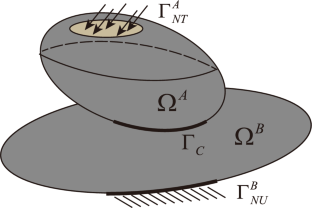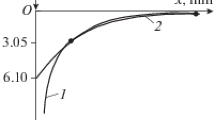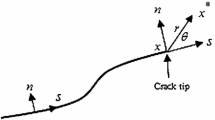Abstract
In this paper, a new strong-form numerical method, the element differential method (EDM) is employed to solve two- and three-dimensional contact problems without friction. When using EDM, one can obtain the system of equations by directly differentiating the shape functions of Lagrange isoparametric elements for characterizing physical variables and geometry without the variational principle or any integration. Non-uniform contact discretization is used to enhance contact conditions, which avoids performing identical discretization along the contact surfaces of two contact objects. Two methods for imposing contact constraints are proposed. One method imposes Neumann boundary conditions on the contact surface, whereas the other directly applies the contact constraints as collocation equations for the nodes within the contact zone. The accuracy of the two methods is similar, but the multi-point constraints method does not increase the degrees of freedom of the system equations during the iteration process. The results of four numerical examples have verified the accuracy of the proposed method.





































Similar content being viewed by others
Data availability
The authors state that all the data necessary to replicate the results are presented in the manuscript. Relevant parts of the code can be shared by contacting the corresponding author.
References
Johnson KL (1985) Contact mechanics. Cambridge University Press, Cambridge
Hertz H (1882) Study on the contact of elastic solids. J Reine Angew Math 92:156–171
Bozorgmehri B, Obrezkov LP, Harish AB et al (2023) A contact description for continuum beams with deformable arbitrary cross-section. Finite Elements Anal Des. https://doi.org/10.1016/j.finel.2022.103863
Gay Neto A, de Pimenta P, M, Wriggers P (2018) Contact between spheres and general surfaces. Comput Methods Appl Mech Eng 328:686–716
Liu GR, Gu YT (2005) An introduction to meshfree methods and their programming. Springer-Verlag, Berlin/Heidelberg
Simo JC, Wriggers P, Taylor RL (1985) A perturbed Lagrangian formulation for the finite element solution of contact problems. Comput Methods Appl Mech Eng 50(2):163–180
Wriggers P (2006) Computational contact mechanics. Springer, Berlin
Dandekar BW, Conant RJ (1992) An efficient equation solver for frictional contact problems using the boundary integral equation formulation. Commun Appl Numer Methods 8:171–178
Man KW, Aliabadi MH, Rooke DP (1993) BEM frictional contact analysis: load incremental technique. Comput Struct 47:893–905
Li G, Belytschko T (2001) Element-free Galerkin method for contact problems in metal forming analysis. Eng Comput 18(1/2):62–78
Chen J-S, Wang H-P (2000) New boundary condition treatments in meshfree computation of contact problems. Comput Methods Appl Mech Eng 187(3–4):441–468
Belgacem FB, Maday Y (1994) A spectral element methodology tuned to parallel implementations. Comput Methods Appl Mech Eng 116(1–4):59–67
Belhachmi Z, Bernardi C (1994) Resolution of fourth-order problems by the mortar element method. Comput Methods Appl Mech Eng 116(1–4):53–58
Maday Y, Mavriplis C, Patera A (1988) Nonconforming mortar element methods: application to spectral discretizations (No.NASA-CR-181729)
Wohlmuth BI (2001) Iterative solvers based on domain decomposition. In: Discretization methods and iterative solvers based on domain decomposition. Lecture Notes in Computational Science and Engineering, vol. 17. Springer, Berlin, Heidelberg
Puso MA, Laursen TA (2004) A mortar segment-to-segment contact method for large deformation solid mechanics. Comput Methods Appl Mech Eng 193(6–8):601–629
Farah P, Popp A, Wall WA (2015) Segment-based vs. element-based integration for mortar methods in computational contact mechanics. Comput Mech 55:209–228
Belgacem FB, Hild P, Laborde P (1998) The mortar finite element method for contact problems. Math Comput Model 28(4–8):263–271
McDevitt T, Laursen T (2000) A mortar-finite element formulation for frictional contact problems. Int J Numer Methods Eng 48(10):1525–1547
Puso MA (2004) A 3D mortar method for solid mechanics. Int J Numer Methods Eng 59:315–336
Yang B, Laursen TA, Meng X (2005) Two dimensional mortar contact methods for large deformation frictional sliding. Int J Numer Methods Eng 62(9):1183–1225
Kim TY, Dolbow J, Laursen T (2007) A mortared finite element method for frictional contact on arbitrary interfaces. Comput Mech 39(3):223–235
Khater AH, Temsah RS, Hassan MM (2008) A Chebyshev spectral collocation method for solving burgers’ type equations. J Comput Appl Math 222(2):333–350
Haq S, Hussain A, Uddin M (2011) RBFs meshless method of lines for the numerical solution of time-dependent nonlinear coupled partial differential equations. Appl Mat 2(4):414–423
Liu GR, Zhang J, Li H, Lam KY, Kee BBT (2006) Radial point interpolation based finite difference method for mechanics problems. Int J Numer Methods Eng 68(7):728–754
Fantuzzi N, Tornabene F, Viola E, Ferreira AJM (2014) A strong formulation finite element method (SFEM) based on RBF and GDQ techniques for the static and dynamic analyses of laminated plates of arbitrary shape. Meccanica 49(10):2503–2542
Wen PH, Cao P, Korakianitis T (2014) Finite block method in elasticity. Eng Anal Bound Elem 46:116–125
Li M, Wen PH (2014) Finite block method for transient heat conduction analysis in functionally graded media. Int J Numer Methods Eng. 99(5):372–390
Li M, Lei M, Munjiza A, Wen PH (2015) Frictional contact analysis of functionally graded materials with Lagrange finite block method. Int J Numer Methods Eng 103(6):391–412
Almasi A, Kim T-Y, Song J-H (2022) Strong form meshfree collocation method for frictional contact between a rigid pile and an elastic foundation. Eng Comput 39(1):791–807
De Lorenzis L, Evans J, Hughes TJ, Reali A (2015) Isogeometric collocation: Neumann boundary conditions and contact. Comput Methods Appl Mech Eng 284:21–54
Kruse R, Nguyen-Thanh N, De Lorenzis L, Hughes TJ (2015) Isogeometric collocation for large deformation elasticity and frictional contact problems. Comput Methods Appl Mech Eng 296:73–112
Zheng YT, Gao XW, Liu YJ (2023) Numerical modelling of braided ceramic fiber seals by using element differential method. Compos Struct 304:116461
Gao XW, Huang SZ, Cui M, Ruan B, Zhu QH, Yang K, Lv J, Peng HF (2017) Element differential method for solving general heat conduction problems. Int J Heat Mass Transf 115:882–894
Gao XW, Li ZY, Yang K et al (2018) Element differential method and its application in thermal-mechanical problems. Int J Numer Methods Eng 113:82–108
Lv J, Shao MJ, Cui M, Gao XW (2019) An efficient collocation approach for piezoelectric problems based on the element differential method. Compos Struct 230:111483
Jiang WW, Gao XW, Xu BB, Lv J (2023) Static and forced vibration analysis of layered piezoelectric functionally graded structures based on element differential method. Appl Math Comput 437:127548
Zheng YT, Gao XW, Lv J, Peng HF (2020) Weak-form element differential method for solving mechanics and heat conduction problems with abruptly changed boundary conditions. Int J Numer Methods Eng 121:3722–3741
Jean M (1999) The non-smooth contact dynamics method. Comput Methods Appl Mech Eng 177(3):235–257
Hughes TJR (1987) The finite element method: linear static and dynamic finite element analysis. Prentice-Hall, New Jersey
Shu X, Zhang J, Han L et al (2016) A surface-to-surface scheme for 3D contact problems by boundary face method. Eng Anal Bound Elem 70:23–30
Funding
This work was supported by the National Natural Science Foundation of China (12072064,12272081) and the Natural Science Foundation of Liaoning Province, China (2022-MS-138).
Author information
Authors and Affiliations
Corresponding authors
Ethics declarations
Conflict of interest
The authors declare that they have no known competing financial interests or personal relationships that could have appeared to influence the work reported in this paper.
Additional information
Publisher's Note
Springer Nature remains neutral with regard to jurisdictional claims in published maps and institutional affiliations.
Appendix A
Appendix A
1.1 The description of symbols and abbreviations
The symbols and abbreviations used in this paper:
Γ | = | Boundary |
Ω | = | Domain |
xi | = | The ith coordinate |
x, x, y, z | = | Coordinates |
u | = | Displacement |
t | = | Traction |
n | = | Outward normal of the surface |
Dijkl | = | Elastic constitutive tensor |
y | = | Coordinates after contact |
gn | = | Normal gap after contact |
Gn | = | Normal gap before contact |
σn | = | Normal contact stress |
ξ, ξ, η, ζ | = | Intrinsic coordinates |
Nα, Nβ | = | Shape function |
M, S | Number of surfaces | |
A | = | Coefficient matrix |
z | = | Vector of unknown |
b | = | Vector of known |
\(K_{ij}^\alpha\) | = | Coefficient matrix for node |
G | = | Coefficient matrix |
C | = | Coefficient matrix by contact equations |
∆ | = | Change of variable |
Superscripts | ||
A, B | = | Object |
m, n, p | = | Number of interpolation points |
α | = | Node |
f | = | Element surface |
k | = | kth iteration |
Subscripts | ||
C | = | Contact |
N | = | Not in contact |
T | = | Neumann boundary |
U | = | Dirichlet boundary |
i, j, k, l | = | The ith, jth, kth, lth component |
α, β | = | Node |
abbreviations | ||
EDM | = | Element differential method |
FEM | = | Finite element method |
BEM | = | Boundary element method |
MFM | = | Mesh-free method |
FDM | = | Fnite difference method |
SFEM | = | Strong-form finite element method |
FBM | = | Finite block method |
Rights and permissions
Springer Nature or its licensor (e.g. a society or other partner) holds exclusive rights to this article under a publishing agreement with the author(s) or other rightsholder(s); author self-archiving of the accepted manuscript version of this article is solely governed by the terms of such publishing agreement and applicable law.
About this article
Cite this article
Fan, WL., Gao, XW., Zheng, YT. et al. Element differential method for contact problems with non-conforming contact discretization. Engineering with Computers (2024). https://doi.org/10.1007/s00366-024-01963-7
Received:
Accepted:
Published:
DOI: https://doi.org/10.1007/s00366-024-01963-7




